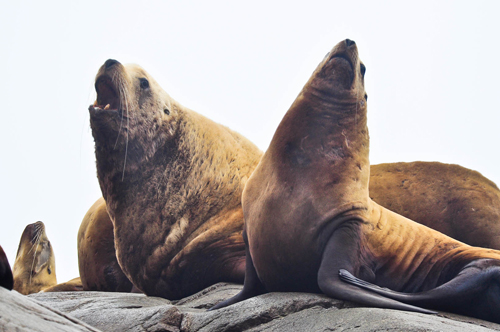
Scientists believe the precipitous decline of Western Alaska’s sea lion populations is driven by changes in the availability of their prey. However, relatively little is known about how much food they need to remain healthy, or how much energy they expend in day-to-day activities like swimming and foraging.
Two new Consortium studies led by Beth Young evaluated the relationship between feeding, activity, heart rate, and energy expenditure. While scientists cannot directly measure the energy a wild sea lion expends, previous studies have established an equation that predicts oxygen consumption (a proxy for energy expenditure) based on heart rate, which is easily measured.
However, the previous equation was calibrated with animals that were resting on land and not feeding. Young and colleagues investigated whether this equation could apply to animals swimming at sea and searching for food.
“An exercise treadmill is a good analogy for how energy expenditure can be estimated from heart rate,” Young says. “The treadmill’s heart rate monitor predicts the number of calories we burn when running or walking, according to a specific equation for that type of exercise. But it does not consider your digestive state, and it is not accurate for other types of exercise. Our study attempted to calibrate a similar equation for sea lions when they are diving or feeding, and not just while they are resting on dry land.”
Land and sea
Young and colleagues examined three potential influences on the relationship between heart rate and oxygen consumption: environment (land vs. water), feeding (fed vs. fasted), and diving (single vs. consecutive). In the first of two studies, published in the Journal for Comparative Physiology, they measured heart rate and respiration in captive Steller sea lions on dry land, in water, and in open water. The sea lions had either been recently fed or had fasted overnight.
“Environment made a big difference,” Young notes. “The relationship between heart rate and oxygen consumption was completely different on land than in water, which suggests that a separate equation is needed to estimate energy spent in swimming animals.”
This is probably because marine mammals have an automatic dive response in water that is absent on land, Young says, which lowers the heart rate and shunts blood away from the extremities.
“The dive response in marine mammals is part voluntary and part involuntary, and it varies with the depth and duration of the dive,” says Young. “Even submergence in shallow water can cause a mild involuntary dive response. We see the same thing in humans — our heart rate drops when we submerge our faces in cold water, even for a few seconds.”
Young and colleagues had expected that feeding would also influence the relationship between heart rate and oxygen consumption in both environments, but found that feeding only had an effect if the sea lion was in water. On land, the equation held true whether the animal was fed or fasted. The size of the meal also had an effect on the heart rate relationship in water, but not on land.
Dives and debts
In a related study published in the Journal of Experimental Biology, Young and colleagues measured heart rate and respiration in active Steller sea lions after single dives and successive dives, or dive bouts. Unlike previous diving studies with captive animals, these dives were made in an open water environment and simulated natural underwater foraging, including feeding at realistic depths (up to 40m) and diving for realistic lengths of time (2-8 min).

Steller sea lion wearing a harness holding a heart rate monitor.
“We demonstrated that heart rate can predict oxygen consumption in individual dives, and that neither depth nor dive duration changed that relationship,” says Young. “But a different equation is needed for dive bouts. We found the relationship only held true over complete dive cycles that included the surface interval following the dive bout.”
A diving animal incurs an oxygen debt during the dives that is paid back at the surface, Young explains. In a single dive, the oxygen debt likely is not large enough to change the relationship between heart rate and oxygen consumption, but over multiple dives the animal accumulates a greater oxygen debt, which does influence that relationship.
In the wild
Ultimately, Young believes her research provides researchers with valuable insights to help assess metabolic rates of wild Steller sea lions.
“By temporarily attaching a heart rate data logger on a wild sea lion, one could predict metabolic rate from its heart rate — with the right equations,” she says. “This is particularly important in identifying how much energy nutritionally stressed animals expend, because it enables us to estimate how much food they need to eat to remain healthy. It also helps fisheries managers assess how much fish is required by wild sea lion populations, versus how much is available.”
Heart rate can predict metabolism, Young concludes, but it cannot be done using a single predictive equation. The relationship between heart rate and energy expenditure differs according to whether the sea lion is on land or in water, whether it has a full or empty stomach, and whether it is diving to depth or swimming along the surface. Thus, separate equations are needed to distinguish among environmental, digestive and diving states. Young recommends modifying the current equations that are based on fasting animals to account for the more realistic activities that sea lions undertake in the wild.
September 7, 2011
PUBLICATION:
|

|

 |
||||||||||||
|

|

 |
||||||||||||
